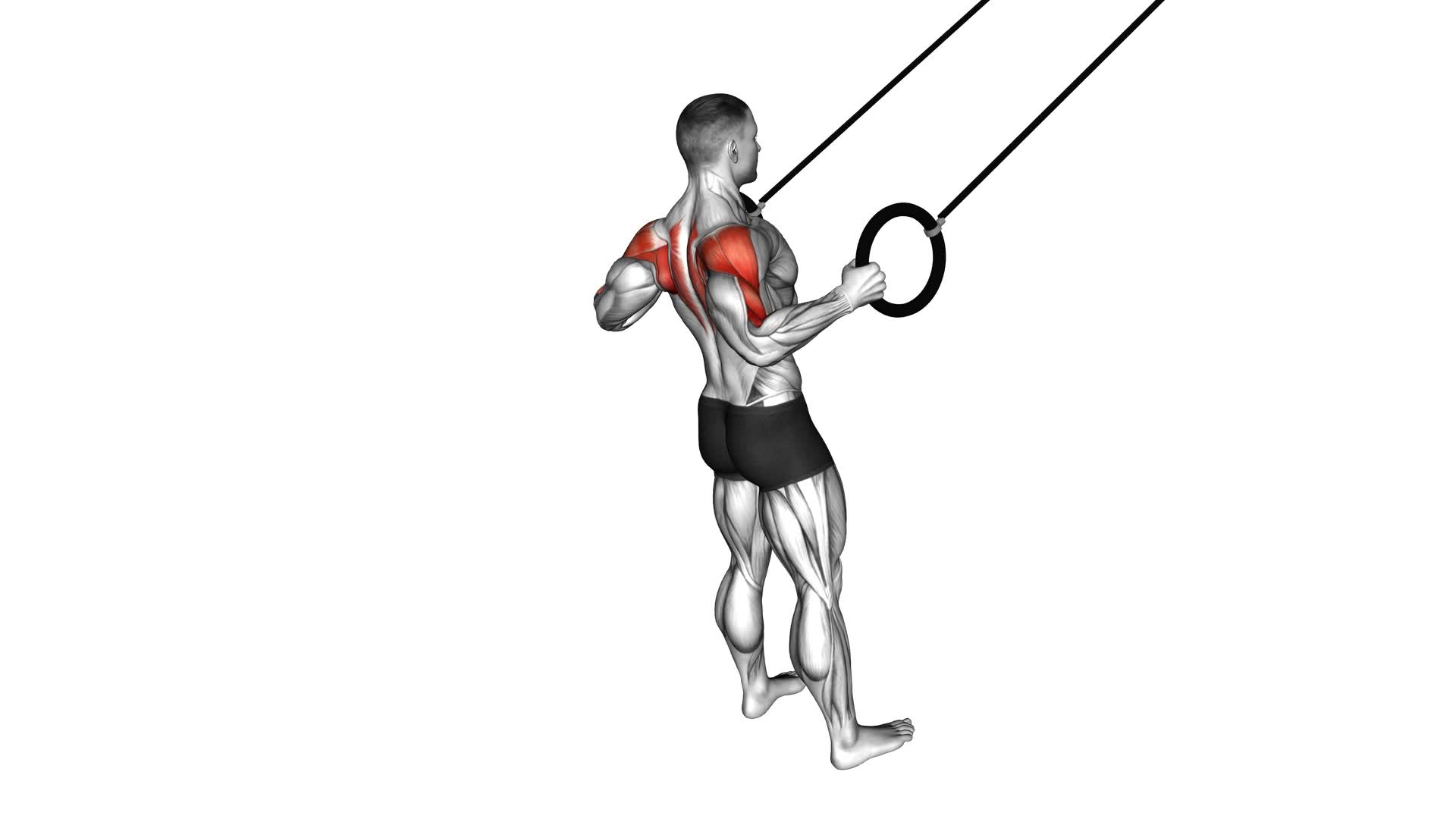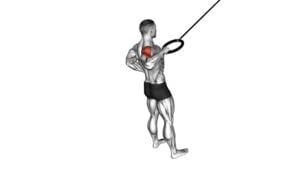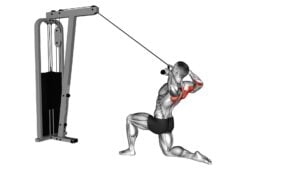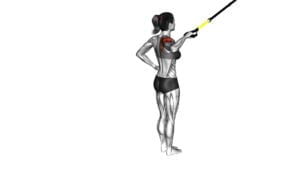Ring Rear Delt Row (male) – Video Exercise Guide & Tips

Looking to strengthen your rear deltoids? Check out this video exercise guide on the Ring Rear Delt Row.
Watch This Exercise Video
Learn the proper form, variations, and modifications to maximize your results. Avoid common mistakes and get expert tips to take your workout to the next level.
Watch the video and get ready to sculpt those shoulders!
Key Takeaways
- Ring Rear Delt Row strengthens and tones rear deltoid muscles
- It targets and engages muscles responsible for shoulder extension and horizontal abduction
- It improves upper body strength and definition
- It enhances overall upper body strength and stability
Benefits of the Ring Rear Delt Row
One major benefit of the Ring Rear Delt Row is that it helps you strengthen and tone your rear deltoid muscles. The rear deltoids are the muscles located at the back of your shoulders, responsible for shoulder extension and horizontal abduction. By performing the Ring Rear Delt Row, you specifically target and engage these muscles, leading to improved strength and definition in your upper body.
In addition to targeting the rear deltoids, the Ring Rear Delt Row also integrates well into a full body workout routine. This exercise not only works your shoulders but also engages other muscles in your upper back, including the rhomboids, trapezius, and latissimus dorsi. This comprehensive engagement of multiple muscle groups helps to enhance overall upper body strength and stability.
By incorporating the Ring Rear Delt Row into your workout routine, you can effectively strengthen and tone your rear deltoid muscles, promoting better posture and shoulder stability. This exercise also contributes to a well-rounded full body workout, ensuring that you engage multiple muscle groups for optimal strength and functional fitness.
Proper Form and Technique
To perform the Ring Rear Delt Row with proper form and technique, focus on maintaining a stable and controlled movement throughout the exercise. This will help maximize muscle activation and prevent common errors that can lead to injury or inefficient results. Here are some key points to keep in mind:
- Begin by grasping the rings with an overhand grip, slightly wider than shoulder-width apart.
- Keep your body in a straight line from head to toe, engaging your core muscles to maintain stability.
- Pull your shoulder blades back and down, squeezing your upper back muscles as you row your body towards the rings.
- Aim to bring your elbows back as far as possible, driving your elbows towards your hips.
- Lower yourself back down in a controlled manner, maintaining tension in your muscles throughout the entire exercise.
By following these guidelines, you can ensure proper form and technique during the Ring Rear Delt Row. This will allow you to effectively target and activate your rear delts, while minimizing the risk of injury and maximizing your results.
Remember to start with a weight that allows you to perform the exercise with proper form, gradually increasing the resistance as you become stronger and more comfortable with the movement.
Variations and Modifications
Try incorporating different grip variations to add variety and challenge to your Ring Rear Delt Row workouts. By changing your grip, you can target different muscles and prevent your workouts from becoming monotonous.
One alternative grip option is the neutral grip, where your palms face each other. This grip places more emphasis on your biceps and forearms, adding an extra challenge to your rows.
Another option is the underhand grip, where your palms face up. This grip engages your biceps and upper back muscles even more, giving you a different feel to your workout.
In addition to grip variations, you can also modify the equipment you use for Ring Rear Delt Rows. Instead of using rings, you can try using a TRX suspension trainer or a resistance band. These alternatives offer similar benefits to rings, but may provide a different level of resistance or stability.
Experimenting with different equipment options can help you find what works best for your body and fitness goals. Remember to always maintain proper form and technique, regardless of the grip or equipment you choose.
Adding variations and modifications to your Ring Rear Delt Row workouts can keep your muscles guessing and prevent plateaus. So, don't be afraid to mix it up and try different grips and equipment options to challenge yourself and keep your workouts enjoyable.
Common Mistakes to Avoid
Avoiding proper form and technique can lead to common mistakes in performing the Ring Rear Delt Row exercise. To ensure you get the most out of this exercise and avoid any potential injuries, it's important to be aware of these common mistakes and how to avoid them:
- Jerking the body: One of the most common mistakes is using momentum to perform the exercise instead of relying on the muscles. This not only reduces the effectiveness of the exercise but also increases the risk of injury. Focus on maintaining control throughout the movement.
- Rounded shoulders: Allowing your shoulders to round forward during the exercise puts unnecessary strain on the shoulder joints. Keep your shoulders pulled back and down to maintain proper posture.
- Gripping too tightly: Holding the rings too tightly can cause tension in the forearms and decrease the engagement of the targeted muscles. Maintain a firm but relaxed grip on the rings.
- Not engaging the core: Neglecting to engage your core can lead to excessive arching or rounding of the back, which can strain the lower back. Keep your core muscles activated throughout the exercise.
- Pulling too high: Pulling the rings too high can shift the emphasis from the rear deltoids to the upper traps. Focus on pulling the rings towards your lower chest to target the rear deltoids effectively.
Tips for Maximizing Results
Focus on maintaining proper form and technique to maximize the results of the Ring Rear Delt Row exercise. This exercise primarily targets the rear deltoids, which are the muscles located at the back of the shoulder. For beginners, it's important to start with a lighter resistance and gradually increase as you become more comfortable with the movement. This will help prevent any unnecessary strain or injury.
To incorporate the Ring Rear Delt Row into your routine, you can perform it as part of your upper body workout. It can be done in conjunction with other exercises that target the back and shoulders, such as pull-ups or lateral raises.
When performing the Ring Rear Delt Row, make sure to keep your back straight and avoid arching or rounding your spine. Maintain a stable core and engage your shoulder blades as you pull the rings towards your chest. Keep your elbows close to your body and squeeze your shoulder blades together at the top of the movement.
Remember to breathe throughout the exercise and focus on the mind-muscle connection. By following these tips and incorporating the Ring Rear Delt Row into your routine, you can effectively strengthen and develop your rear deltoids for improved shoulder stability and overall upper body strength.
Frequently Asked Questions
How Many Sets and Reps Should I Do for the Ring Rear Delt Row Exercise?
To get the most out of the ring rear delt row exercise, it's important to know how many sets and reps to do. Start with 3 sets of 12-15 reps, focusing on maintaining proper form throughout.
This exercise targets the rear delts, so make sure to squeeze your shoulder blades together at the top of each rep.
If you want to increase the intensity, you can try slowing down the movement or adding resistance bands.
Can This Exercise Be Done With Dumbbells or Resistance Bands Instead of Rings?
Yes, you can definitely do variations of this exercise using dumbbells or resistance bands instead of rings. Dumbbell variations allow you to target your rear delts effectively while providing stability.
On the other hand, using resistance bands adds an extra level of challenge by providing constant tension throughout the movement.
Both options offer their own unique benefits and can be great alternatives if you don't have access to rings.
Is the Ring Rear Delt Row Suitable for Beginners or Should It Only Be Done by Advanced Lifters?
The ring rear delt row is a great exercise for beginners. It targets your rear deltoids, helping to strengthen and tone your upper back.
The rings provide a challenging and unstable surface, forcing your muscles to work harder to stabilize your body.
If you're new to this exercise, start with lighter weights or resistance bands to build strength and technique.
As you progress, you can increase the intensity by using heavier weights or adjusting the angle of the rings.
Can the Ring Rear Delt Row Help Improve Posture?
The ring rear delt row is an effective exercise that can help improve your posture. By targeting the rear deltoids, it strengthens the muscles in your upper back, which can help counteract the effects of poor posture.
To perform the exercise correctly, start by gripping the rings with your palms facing each other. Keep your core engaged and pull your shoulder blades back as you row your elbows out to the sides.
Remember to maintain proper form throughout the movement for best results.
Are There Any Alternative Exercises That Target the Same Muscles as the Ring Rear Delt Row?
If you're looking for alternative exercises that target the same muscles as the ring rear delt row, there are a few options you can try.
One option is the dumbbell bent over reverse fly, which also works the rear deltoids.
Another exercise is the cable face pull, which targets both the rear delts and the upper back.
To properly perform the ring rear delt row, make sure to keep your back straight and engage your rear delts by squeezing your shoulder blades together.
Conclusion
Incorporating the ring rear delt row into your workout routine can provide numerous benefits. This exercise is great for strengthening your rear deltoids and improving your posture. To perform this exercise correctly, it is important to focus on maintaining proper form and technique. You should also consider modifying the exercise to suit your fitness level.
One common mistake to avoid is using excessive weight. It is important to choose a weight that challenges you, but is still manageable. Using too much weight can compromise your form and increase the risk of injury.
Another mistake to avoid is neglecting to engage your core. Your core muscles play a crucial role in stabilizing your body during the exercise. By keeping your core engaged, you can maintain proper alignment and maximize the effectiveness of the exercise.
By following these tips, you can maximize your results and achieve optimal muscle development in your shoulders and upper back.

Author
Years ago, the spark of my life’s passion ignited in my mind the moment I stepped into the local gym for the first time. The inaugural bead of perspiration, the initial endeavor, the very first surge of endorphins, and a sense of pride that washed over me post-workout marked the beginning of my deep-seated interest in strength sports, fitness, and sports nutrition. This very curiosity blossomed rapidly into a profound fascination, propelling me to earn a Master’s degree in Physical Education from the Academy of Physical Education in Krakow, followed by a Sports Manager diploma from the Jagiellonian University. My journey of growth led me to gain more specialized qualifications, such as being a certified personal trainer with a focus on sports dietetics, a lifeguard, and an instructor for wellness and corrective gymnastics. Theoretical knowledge paired seamlessly with practical experience, reinforcing my belief that the transformation of individuals under my guidance was also a reflection of my personal growth. This belief holds true even today. Each day, I strive to push the boundaries and explore new realms. These realms gently elevate me to greater heights. The unique combination of passion for my field and the continuous quest for growth fuels my drive to break new ground.







